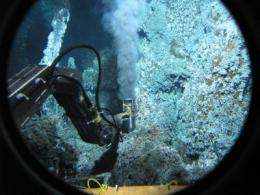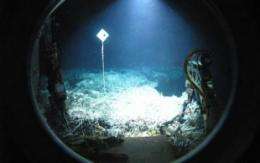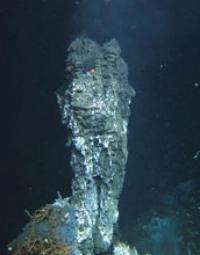First detailed report defines limits of methane-exhaling microbial life in an undersea volcano

By some estimates, a third of the Earth's organisms by mass live in our planet's rocks and sediments, yet their lives and ecology are almost a complete mystery. This week, microbiologist James Holden at the University of Massachusetts Amherst and others report in Proceedings of the National Academy of Sciences the first detailed data about a group of methane-exhaling microbes that live deep in the cracks of hot undersea volcanoes.
Holden says, "Evidence has built over the past 20 years that there's an incredible amount of biomass in the Earth's subsurface, in the crust and marine sediments, perhaps as much as all the plants and animals on the surface. We're interested in the microbes in the deep rock, and the best place to study them is at hydrothermal vents at undersea volcanoes. Warm water flows bring the nutrient and energy sources they need."
"Just as biologists studied the different habitats and life requirements for giraffes and penguins when they were new to science, for the first time we're studying these subsurface microorganisms, defining their habitat requirements and determining how those differ among species. It's very exciting, and will advance our understanding of biogeochemical cycles in the deep ocean."
The study also addresses such questions as what metabolic processes may have looked like on Earth 3 billion years ago and what alien microbial life might look like on other planets. Further, because the study involves methanogens, microbes that inhale hydrogen and carbon dioxide to produce methane as waste, it may also shed light on terrestrial natural gas formation.

One major goal was to test results of predictive computer models and establish the first environmental hydrogen threshold for hyperthermophilic (super-heat-loving) methanogenic (methane-producing) microbes in hydrothermal fluids. "Models have predicted the habitability of the rocky environments that we're most interested in, but we wanted to ground truth into these models and refine them," Holden explains.
In a 2-liter bioreactor at UMass Amherst where she could control hydrogen levels, graduate student Helene Ver Eecke grew pure cultures of hyperthermophilic methanogens from their study site alongside a commercially available hyperthermophilic methanogen species as a control. She found growth kinetics for the three organisms were about the same. That is, all grew at the same rate when given equal amounts of hydrogen and had the same minimum growth requirements. "These experiments established for the first time that these methanogens need at least 17 micromolar of hydrogen to grow," Holden says.
Investigators from several institutions brought an unusually rich mix of expertise to this work. Holden and Ver Eecke at UMass Amherst used culturing techniques to look for organisms in nature and then study their growth kinetics in the lab. Co-investigators Julie Huber at the Marine Biological Laboratory on Cape Cod provided molecular analyses of the microbes while David Butterfield and Marvin Lilley at the University of Washington contributed geochemical fluid analyses.
Using the research submarine Alvin, they collected samples of hydrothermal fluids flowing from black smokers up to 350 degrees C (662 degrees F) and seeping out of ocean floor cracks at lower temperatures. Samples were from Axial Volcano and the Endeavour Segment, both long-term observatory sites along an undersea mountain range about 200 miles off the coast of Washington and Oregon and 1-1.5 miles below the surface.

"We use specialized sampling instruments to measure both the chemical and microbial composition of hydrothermal fluids," says Butterfield. "This is an effort to understand the biological and chemical factors that determine microbial community structure and growth rates." At the Axial site, they found hydrogen above their methanogen threshold for growth and molecular, organismal and geochemical evidence of on-going methanogenesis, while at Endeavour hydrogen levels were below their threshold and evidence for methanogenesis was largely absent. Others have taken culture and fluid samples around the world, so Holden and colleagues analyzed these as well and confirmed the lower threshold of hydrogen concentration needed by these methanogens.
There was a final happy twist awaiting the researchers as they pieced together a picture of how these methanogens live and work. At the low-hydrogen Endeavour site, they found that a few hyperthermophilic methanogens can eke out a living by feeding on the hydrogen waste produced by other hyperthermophiles.
"This was extremely exciting," says Holden. "We hypothesized that the methanogens grow syntrophically with the hydrogen producing microbes, and it worked out that way in the lab with a strain from the site. So we have described a methanogen ecosystem that includes a symbiotic relationship between microbes, which in my mind highlights the strength of our multi-pronged team approach. It really paid off. We feel that more research coupling broad field measurements with laboratory experiments will be really fruitful in the future."
Journal information: Proceedings of the National Academy of Sciences
Provided by University of Massachusetts Amherst















